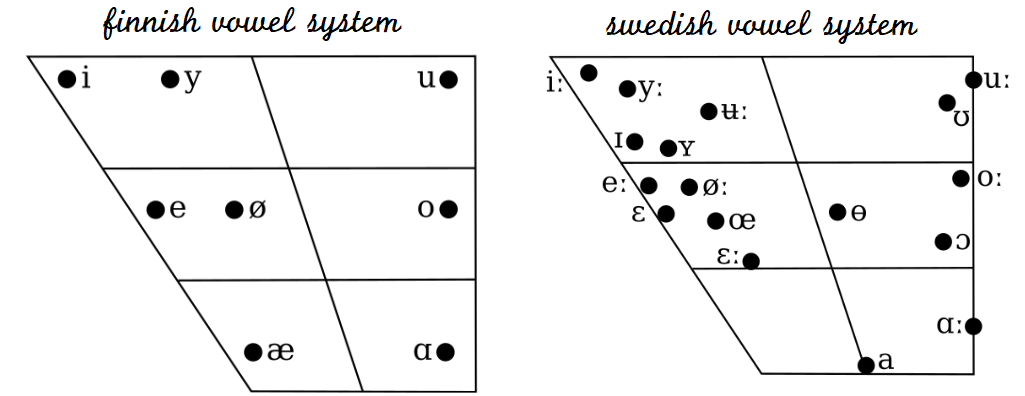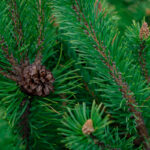Finnish -ATA Verbs Borrowed from Swedish
This article deals with the origins of Finnish verbs ending in –ata. More specifically, we will take a look at Finnish –ata verbs borrowed from Swedish.
Next to English, Swedish is the largest source of –ata verbs. Because you know English, you’re very likely to recognise the origin of verbs adopted from English (e.g. googlata, tekstata, twiitata). Knowing Swedish will likewise give you an advantage.
Since I don’t speak Swedish at all, I’ve been lucky enough to be able to work together with 𝔸𝕕𝕒𝕞 – a native Swedish speaker- from the Uusi kielemme discord server. Without him, this article might never have made it here.
- Which verbs are included in this list?
- Explanations of the table
- Finnish -ATA verbs borrowed from Swedish
- The semantics of loanwords
- The age of loanwords
- The history of loanwords
- The source of loanwords
- The meaning of loanwords
- Loanwords in clusters
- Dictionaries are always running behind
- Phonology of Swedish loanwords
- Foreign consonants
- Consonant clusters
- Pronunciation of vowels
- Vowel harmony
- Consonant gradation
1. Which verbs are included in this list?
For this article, I have searched for *ata in Kielitoimiston sanakirja. By putting an asterisk * in front of the search word, you tell the dictionary to return all words that end in the letters after the asterisk. As such, this article only contains words ending in -ata.
Included in this list are only verbs where the Swedish origin is fairly clear. However, it’s always possible that words have been adopted into Finnish via a different path. It is quite likely, for example, that some of these have been adopted from another Germanic language, or even earlier on, from Proto-Germanic.
Many of the verbs in my list are considered colloquial, dialect or slang words. The list is far from exhaustive; you could certainly think of many more slang words to add to it. Especially if you live in the Helsinki area, you’re bound to hear a lot of Swedish origin slang words. None of those words are included here because I’ve limited my scope to only verbs that can be found in the dictionary I used.
2. Information in the table
2.1. The numbers
As mentioned, many of these verbs are considered colloquial, dialectic or slang words. In the table below, they’re marked with a number. This should give you more of an idea of how accepted these words are. My numbering system is based on Kielitoimiston sanakirja. Verbs marked with #1 are just regular verbs, which aren’t marked in any special way. Verbs with #2 are considered informal everyday colloquialisms. In the dictionary, these were marked with “ark.” for arkikielinen. The verbs marked with #3 had the abbreviation “slg.” in the dictionary, which means they’re slang words.
2.2. Meaning and Synonyms in Finnish
Quotation marks: Between quotation marks “”, you can find the translation of the Swedish origin verb. I’m not listing all the meanings of the verbs, nor necessarily mentioning the most common meaning. The translation provided between quotation marks is the one that best matches up with the Finnish meaning.
Italics: If the Swedish translation matches up with the Finnish -ata word’s meaning, you will find different ways of expressing the same thing in italics behind the quotation marks. Sometimes the italics will contain just a synonym for the -ata verb. In other cases, it can be an explanation of the verb in Finnish. This is the case when Finnish doesn’t have a straight synonym for the verb.
Symbol >: If the meaning of the verb in Finnish is different from the Swedish translation, the quotation marks will be followed by the symbol > and the current translation of the Finnish verb and, then, the synonyms in Finnish.
3. Finnish -ATA Verbs Borrowed from Swedish
| # | Finnish | Swedish | Meaning & Synonyms in Finnish |
|---|---|---|---|
| 2 | blandata | blanda | “to mix together” > to mix, to dilute alcoholic drinks laimentaa |
| 2 | landata | blanda | “to mix together” > to mix, to dilute alcoholic drinks laimentaa |
| 2 | bluffata | bluffa | “to bluff” hämätä, harhauttaa |
| 2 | bongata | boäng | “noun: point” > tehdä ja kirjata ylös (lintu)havaintoja |
| 1 | briljeerata | briljera | “to show off” > to show off, to shine loistaa taidollaan |
| 2 | buukata | boka | “to book” varata |
| 1 | drapeerata | drapera | “to drape” poimuttaa, laskostaa |
| 2 | duunata | dona | “to do small chores” > to work (any work) tehdä työtä, olla työssä |
| 2 | dyykata | dyka | “to dive” > to dumpster dive hankkia tavaroita roskalaatikoista |
| 2 | eksisteerata | existera | “to exist” olla olemassa |
| 1 | entrata | ändra | “to change, modify” muuttaa, korjata |
| 3 | fibata | fiba | “noun, slang: error, blunder” tehdä virhe, mokata |
| 2 | friskata | friska upp | “to refresh” virkistää, piristää |
| 2 | fundeerata | fundera | “to ponder” miettiä, pohtia |
| 2 | funtsata | funta | “to ponder” miettiä, pohtia |
| 2 | fuskata | fuska | “to cheat” pelata vilpillisesti, petkuttaa |
| 1 | föönata | föna | “to blowdry” kuivata hiukset hiustenkuivaajalla |
| 2 | haalata | hala | “to haul” vetää, kantaa vaivalloisesti |
| 2 | hamstrata | hamstra | “to hoard” kerätä varastoon |
| 3 | hengata | hänga | “to hang” > to hang out with kulkea, roikkua mukana |
| 2 | hoksata | hågsa | “dialect: to remember, think” > to figure out, realize tajuta, älytä |
| 2 | hyysätä | hysa | “to house” to pamper s.o. undeserving auttaa jkta joka ei ansaitse sitä |
| 2 | jammata | jamma | “to jam” soittaa jameissa, vapaasti improvisoiden |
| 2 | jelpata | hjälpa | “to help” auttaa |
| 3 | jemmata | gömma | “to hide” > to stash, stockpile kätkeä, varastoida |
| 1 | jongleerata | jonglera | “to juggle” heitellä ilmaan palloja, keiloja |
| 2 | juksata | joxa | “to cheat, to play tricks” huijata, petkuttaa |
| 1 | jumpata | gympa | “noun: gymnastics” > to exercise voimistella |
| 2 | justeerata | justera | “to adjust, to tweak” järjestää, laittaa kuntoon |
| 1 | kaapata | kapa | “to capture, hijack” siepata, tehdä kaappaus |
| 3 | karahteerata | karaktär | “noun: nature, character” > to call by a title nimittää, kutsua arvonimellä |
| 1 | keilata | kägla | “noun: tenpin” > to bowl harrastaa keilailua |
| 2 | kokata | koka | “to boil” > to cook laittaa ruokaa, keitellä |
| 2 | kollata | kolla | “to control, check” tarkistaa |
| 2 | koplata | koppla | “to connect, couple” kytkeä |
| 2 | kruksata | kruxa | “to make markings, checkmarks” > to tick a box rastittaa |
| 1 | kuiskata | viska | “to whisper” puhua hyvin hilkaa |
| 1 | kurlata | gurgla | “to gargle” huuhdella kurkkuaan |
| 2 | kuskata | kuska | “to drive” > to be the driver kuljettaa, kyyditä |
| 2 | kuurata | skura | “to scrub” pestä hankaamalla |
| 1 | ladata | ladda | “to load, to charge” täyttää sähköllä, liittää osia |
| 2 | lahdata | slakta | “to slaughter” teurastaa; tappaa joukoittain |
| 1 | lanseerata | lansera | “to launch” julkaista markkinoille |
| 1 | lastata | lasta | “to load cargo” kuormata, täyttää lastilla |
| 2 | lespata | läspa | “to lisp” suhauttaa s-äännettä |
| 1 | maskeerata | maskera | “to mask” naamioida, muuttaa ulkonäköä |
| 2 | meinata | mena | “to mean” > to mean; to plan, intend tarkoittaa; aikoa, suunnitella |
| 2 | missata | missa | “to miss” pilata, epäonnistua; hukata, jättää väliin |
| 2 | montteerata | montera | “to mount, install, assemble” asentaa |
| 1 | napata | nappa | “to nip, to take bait” > to take, snatch, grab siepata, kopata |
| 1 | narrata | narra | “to fool” puhua perättömiä, huijata, jujuttaa |
| 1 | niiata | niga | “to curtsey” tervehtiä polviaan notkistaen |
| 1 | niitata | nita | “to rivet” > to staple liittää niiteillä |
| 1 | noteerata | notera | “to note, notice” panna merkille, kirjata ylös |
| 1 | nyplätä | knyppla | “to make lace” > to fiddle with tehdä pitsiä, hypistellä |
| 1 | pakata | packa | “to pack” laittaa pakkaukseen kuljetusta, säilytystä, myymistä varten |
| 1 | pedata | bädda | “to make the bed” sijata sänky |
| 1 | pelata | spela | “to play” osallistua peliin |
| 1 | permanentata | permanenta | “to perm” tehdä permanentti |
| 1 | pestata | fästa | “archaic: to sign on, to engage” > to hire palkata palvelukseen, värvätä |
| 2 | petrata | bättra | “to improve” parantaa, korjata |
| 2 | piisata | spisa | “to eat, feed, suffice” riittää |
| 1 | piiskata | piska | “to whip” lyödä piiskalla |
| 2 | plarata | bläddra | “to leaf, browse” selata |
| 2 | plaseerata | placera | “place, to set” > to seat people sijoittaa, asettaa |
| 1 | pliseerata | plissera | “to pleat” laskostaa, poimuttaa |
| 1 | poseerata | posera | “to pose” pysyä mallina tietyssä asennossa |
| 1 | povata | spå | “to foretell” ennustaa korteista, kämmenestä |
| 2 | prepata | preppa | “to prepare, esp. for an exam” valmentaa tutkintoon, kokeisiin |
| 1 | pumpata | pumpa | “to pump” käyttää pumppua |
| 2 | pussata | pussa | “to kiss” suudella |
| 2 | putsata | putsa | “to clean, to shine” puhdistaa |
| 2 | puunata | bona | “to wax, to polish” vahata, kiillottaa |
| 2 | buunata | bona | “to wax, to polish” vahata, kiillottaa |
| 2 | pykätä | bygga | “to build” rakentaa |
| 2 | pyntätä | pynta | “to decorate, adorn” > to dress pukea runsaisiin tai koreisiin vaatteisiin |
| 2 | pyykätä | byka | “to wash laundry” pestä pyykkiä |
| 1 | pärjätä | bärga sig | “to cope, manage” selviytyä, suoriutua |
| 1 | raahata | draga | “to draw, pull” kuljettaa jtak voimia ponnistaen, laahaten |
| 2 | raakata | raka | “to shave” ajaa partaa |
| 1 | raapata | skrapa | “to scrape off” raapia, kaapia |
| 2 | rampata | trampa | “to walk, to step, to tramp” kulkea, kävellä edestakaisin, tulla ja mennä |
| 1 | rapata | rappa | “to plaster” päällystää laastilla, laastita |
| 2 | ravata | trava | “to trot” > to come by (too) often juosta, käydä liian usein |
| 2 | reissata | resa | “dialect: to travel” matkustaa |
| 3 | friiata | fria | “to propose (archaic: to woo, court)” kosiskella, seurustella |
| 2 | riiata | fria | “to propose (archaic: to woo, court)” kosiskella, seurustella |
| 1 | riskeerata | riskera | “to risk” ottaa riski |
| 1 | roskata | roska ner | “to litter” tuottaa, levittää roskaa |
| 2 | rustata | rusta | “to equip, to build” valmistaa, väsätä |
| 1 | ryövätä | röva | “to plunder, rob” ryöstää |
| 2 | räknätä | räkna | “to count” laskea, pitää lukua |
| 1 | saneerata | sanera | “to renovate, redevelop” korjata, uusia, kunnostaa |
| 2 | satsata | satsa | “to invest” panostaa, sijoittaa |
| 2 | seilata | segla | “to sail” purjehtia |
| 2 | serveerata | servera | “to serve, wait on” tarjota, tarjoilla |
| 1 | signeerata | signera | “to sign” merkitä nimikirjoituksella, allekirjoittaa |
| 1 | siteerata | citera | “to cite” lainata sanoja |
| 2 | skoolata | skåla | “to toast” juoda malja, kilistää lasia |
| 2 | sliipata | slipa | “to whet, sharpen, polish” hioa sileäksi |
| 2 | stemmata | stämma | “to match, fit, add up” täsmätä |
| 2 | spurtata | spurta | “to sprint, dash” kiriä |
| 2 | stopata | stoppa | “to cause to stop” seisauttaa, pysäyttää |
| 2 | syynätä | syna | “to inspect, check” tarkastaa, tutkia |
| 1 | tankata | tanka | “to fuel, to refuel” lisätä polttoainetta ajoneuvoon |
| 1 | tavata | stava | “to spell” lukea sana tavu kerrallaan |
| 1 | tiskata | diska | “to wash dishes” pestä astiat |
| 2 | stopata | stoppa | “to fill, stuff” pehmustaa, täyttää |
| 2 | trahteerata | traktera | “to cater to a guest” kestitä, tarjoilla |
| 1 | treenata | träna | “to work out, exercise” harjoitella, harjoittaa |
| 2 | treffata | träffa | “to meet” tavata, kohdata |
| 2 | tsempata | kämpa | “to fight” > to perservere, to hang on kamppailla, ponnistella |
| 3 | tsiigata | kika | “to look” katsoa, katsella. |
| 3 | tsiikata | kika | “to look” katsoa, katsella. |
| 1 | tupeerata | tupera | “to backcomb” pöyhöttää tukkaa |
| 2 | tykätä | tycka om | “to be fond of” pitää, tuntea mieltymystä |
| 1 | uhrata | offra | “to sacrifice” luopua jostain, lahjoittaa jumalille |
| 2 | vahdata | vakta | “to guard” > to guard; to stare vahtia, valvoa, tuijottaa |
| 3 | venata | vänta | “to wait” odottaa |
| 3 | ventata | vänta | “to wait” odottaa |
| 2 | viikata | vika | “to fold” taittaa, laskostaa |
| 1 | vinkata | vinka | “to wave” > to beckon, give sign; to give a tip viitata; antaa vinkki |
| 1 | virkata | virka | “to crochet” tehdä langasta koukulla silmukoita |
| 2 | vislata | vissla | “to whisle” viheltää |
| 1 | vispata | vissla | “to whip, whisk” vatkata |
| 1 | värjätä | färga | “to color, dye, paint” muuttaa jonkin väriseksi |
| 1 | värkätä | verka | “to work” > to tinker puuhata, väsätä |
| 1 | värvätä | värva | “to enlist, recruit” palkata, pestata |
4. The Semantics of -ATA Verbs Borrowed from Swedish
4.1. The Age of Loanwords
Not all loanwords are the same age, so not all words were adopted into Finnish at the same time. Please note that Sweden’s influence on Finland has existed for many centuries and that Swedish words have made their way into the Finnish language over a long period.
For example, the word ruuvata (Eng. to screw, Sw. skruva) is much older than the word föönata (Eng. to blowdry, Sw. fööna). For some words, linguists can tell when they were adopted, for others it is more difficult to say.
4.2. The History of Loanwords
This page contains words that (most probably) made their way into Finnish through Swedish. However, it’s not always that obvious. Sometimes the Swedish word and the English word are really close. For example, did Finns get the verb jammata from the English “to jam” or the Swedish “jamma”? How about rokata, “to rock” and “rocka”? It’s been theorized that these words didn’t make it into Finnish directly from English: they probably took a detour through Sweden.
In addition, taking one step back at where a word has come from isn’t always enough. Words can travel from language to language over the ages. I learned, for example, that many Swedish words ending in -era actually come from French words! We can even assume that – before they made it to French – they were alive and well in some form or another in Latin words.
FINNISH pliseerata (“to pleat”) < SWEDISH plissera (“to pleat”) < FRENCH plisser (“to pleat”) – more examples here.
4.3. The Source of Loanwords
Loanwords don’t have to originate from official, standard language words. They can be based on regional dialects of words. For example, the verb hoksata “to figure out, to understand” likely comes from the dialectal Swedish hågsa “to remember, to think”. In ancient Swedish and Icelandic hugsa means “to think”.
4.4. The Meaning of Loanwords
The Swedish word might have changed its meaning since its adoption. It might mean something different in current Swedish than it did at the time when it became a Finnish word. Likewise, the meaning of the Finnish word can also have evolved away from the Swedish meaning. Words can get more specific meanings, or they might broaden out to include more things into their meaning. 𝔸𝕕𝕒𝕞 brought up a related tidbit of information concerning the verb napata, which in Finnish means “to grasp, snatch, take”, from the Swedish verb nappa:
𝔸𝕕𝕒𝕞: Nappa means to bite, like a fish taking a bait. It can also mean to jump at something, accept something with enthusiasm. The oldest meaning in my historical dictionary is ‘nibble’ and then comes ‘grab, catch’. In Finnish the idea of being lured into biting/grabbing/catching something is lost. In Swedish you can’t nappa something unless it’s bait or at least something offered to you.
4.5. Loanwords in Clusters
Words often come in clusters: you get multiple words that are all connected to each other. There are large word clusters such as the one related to the noun kirja, which includes e.g. kirjata : kirjoittaa : kirjaus : kirjain : kirjoitus.
Languages can develop these words on their own. For example, Finnish can have borrowed the noun maali “paint” from the Swedish mål, and then made a verb out of maali themselves: maalata “to paint”. However, Finnish can also have borrow both the noun and the verb separately (so maali from Swedish mål, and maalata from Swedish måla). Linguists put a lot of time and effort into making accurate presumptions about the origins of words, which is a pretty difficult job.
4.6. Dictionaries are Always Running Behind
Dictionaries of course don’t accept every little word that gains some popularity into the dictionary right away. This has consequences on my word list because I’m limited to those words that have been around long enough to be accepted into the dictionary. There is also always the risk that a verb that was marked as “slang” in the dictionary has been adopted more fully and is merely “colloquial” now.
There are certainly many commonly used Swedish loanwords that aren’t in my list. I’m pretty sure there must be lots of them in the Helsinki area. Here are some words whose official status is still pending:
- ruukata “to be in the habit of”, from Swedish bruka
- simmata/tsimmata “to swim”, from Swedish simma
5. The Phonology of -ATA Verbs Borrowed from Swedish
When adopting words from other languages, there is always the issue of certain sounds not existing in the target language. There are different ways that these words will be adjusted to fit the adopting language. Below you can find out more about how loanwords from Swedish have been modified to fit the Finnish consonant and vowel system.
5.1. Foreign Consonants
Some consonants (e.g. b, d, g) don’t occur naturally in native Finnish words. We will see a tendency to avoid these consonants. These are, however, just tendencies. It really depends on the word. In the table below, you can see some of these tendencies.
| Change | Swedish |
|---|---|
| g > k | gurgla > kurlata |
| g > Ø | gurgla > kurlata, kägla > keilata |
| ɕ > ts | kika > tsiikata, kämpa > tsempata |
| b > p | bättra > petrata, bädda > pedata |
| d > t | diska > tiskata, ändra > entrata |
| d = d | dona > duunata, dyka > dyykata |
| kt > ht | traktera > trahteerata, karaktär > karahteerata |
The Swedish verb kika “to look” is super interesting. It is pronounced as /ˈtɕiːka/ (Finland Swedish) or /ˈɕiːka/ (Sweden Swedish). This has been adopted into Finnish as /ts/: tsiikata/tsiigata.
The Swedish word kägla “tenpin” is also pronounced with /(t)ɕ/ in the beginning. However, its Finnish, adopted form is keilata. It’s thought that this verb was possibly adopted into Finnish before the Swedish pronounciation changed, while tsiikata is a newer loanword.
5.2. Consonant Clusters
Finnish words also undergo a tendency to remove consonant clusters (multiple consonants in a row). However, there are plenty of Swedish loanwords that have – at least orthographically – retained their consonant clusters.
It’s important to note that we’re dealing with the written versions of these verbs. The spoken version often differs from the written form. Take for example the verbs stressata and treenata. Those are their written form, but you’re likely to hear ressata and reenata.
| Change | Swedish |
|---|---|
| bl > l | blanda > blandata, lantata |
| sl > l | slakta > lahdata |
| fr > r | fria > riiata |
| tr > r | trampa > rampata |
| tr = tr | träffa > treffata, träna > treenata |
| dr > r | draga > raahata |
| skr > r | skrapa > raapata |
| sk > k | skura > kuurata |
| sk = sk | skåla > skoolata |
5.3. Pronunciation of Vowels
Vowels are equally interesting as consonants, but harder to put in a nice table. Different languages have different types and numbers of vowels.
- 𝔸𝕕𝕒𝕞: Swedish å is pronounced like Finnish o.
- 𝔸𝕕𝕒𝕞: Swedish o is either pronounced like Finnish o or u, depending on the word.
- 𝔸𝕕𝕒𝕞: Swedish u sounds like somewhere in between Finnish y and ö depending on the word. But in Swedish as it’s spoken in Finland today, it can also be quite similar to Finnish u.

I feel (more) out of my depth (than usual) with the phonological changes vowels undergo. It’s also hard to put them in tables based on their written form, because the orthographic (written) versions of Swedish vowels don’t fit together well with the Finnish orthography. I don’t have a good enough grasp on the way IPA marks sounds to use their phonological system.
In general, we can say that in most cases words borrowed from Swedish will have been borrowed based on their spoken form; not based on their orthography. There seems to be somewhat of a tendency with these borrowed verbs that, when a sound is pronounced “long” in Swedish, it will also be pronounced “long” in Finnish. This is especially clear with Swedish verbs ending in -era. For example, notera > noteerata, fundera > fundeerata.
However, 𝔸𝕕𝕒𝕞 pointed out two examples of opposing sound changes with piska [pɪs:ka] vs piiskata (Swedish short > Finnish long) and koka [ku:ka] vs kokata (Swedish long > Finnish short). I’ll leave further comparisons of the Finnish and Swedish vowel systems to those more qualified than I!
5.4. Vowel Harmony
Swedish doesn’t have Finnish-style vowel harmony, so in order to make a loanword fit perfectly into Finnish, some of the vowels would have to be changed. The word list below contains three verbs that ought to be subject to the vowel harmony rules.
However, two of them don’t follow the pattern: dyka > dyykata (not dyykätä) and föna > föönata (not föönätä). The third verb has indeed been changed to conform with the vowel harmony rules: hysa > hyysätä. I will address this topic further in a future article.
5.5. Consonant Gradation
The following table only consists of the verbs that undergo consonant gradation. I will be publishing a more detailed article on consonant gradation in loanwords like these in the near future. For now, you can see from the table below that, in particular, -kk-, -pp- and -tt- will change.
The double consonants in Finnish make sense from a phonological point of view. A Finn listening to the pronunciation of boka or kapa, for example, has likely heard and interpreted them as “buukka” and “kaappa”. This is an interesting example of how a language can sound to the uninitiated: someone who knows Swedish will not consider the consonant in these words “long” phonologically, as I found out from 𝔸𝕕𝕒𝕞.
In any case, the Finnish double consonants from the conjugated form will be weak in the basic form. This is due to phonological reasons (which we will look at in a different article).
| Finnish | Swedish | Minä-form |
|---|---|---|
| buukata | boka | buukkaan |
| kokata | koka | kokkaan |
| dyykata | dyka | dyykkaan |
| tankata | tanka | tankkaan |
| pakata | packa | pakkaan |
| pyykätä | byka | pyykkään |
| tykätä | tycka | tykkään |
| viikata | vika | viikkaan |
| vinkata | vinka | vinkkaan |
| virkata | virka | virkkaan |
| jelpata | hjälpa | jelppaan |
| jumpata | gympa | jumppaan |
| prepata | preppa | preppaan |
| kaapata | kapa | kaappaan |
| napata | nappa | nappaan |
| raapata | skrapa | raappaan |
| rampata | trampa | ramppaan |
| rapata | skrapa | rappaan |
| sliipata | slipa | sliippaan |
| tsempata | kämpa | tsemppaan |
| pumpata | pumpa | pumppaan |
| topata | stoppa | toppaan |
| niitata | nita | niittaan |
| spurtata | spurta | spurttaan |
| ventata | vänta | venttaan |
| permanentata | permanenta | permanenttaan |
| pyntätä | pynta | pynttään |
| pedata | bädda | petaan |
| vahdata | vakta | vahtaan |
| lahdata | slakta | lahtaan |
| ladata | ladda | lataan |
Some more example of the history of words
- FRENCH ORIGIN: Finnish: plisseerata (“to pleat”) < Swedish: plissera (“to pleat”) < French: plisser (“to pleat”)*
- LATIN ORIGIN: Finnish: palaveerata < Finnish: palaveri < English: palaver (“keskustelu, jaarittelu”) < Portuguese: palavra (“puhe, sana”) < Latin: parabola (“vertaus, puhe”)*
- GERMAN ORIGIN: Finnish: hamstrata (“to hoard”) < Swedish: hamstra (“to hoard”) < German: hamstern (“to hoard”)*
- PROTO-GERMANIC ORIGIN: Finnish: riiata < Swedish: fria < Old Norse: frjá < Proto-Germanic *frijōną
- PROTO-INDO-EUROPEAN ORIGIN: Finnish: skarpata < Finnish: skarppi < Swedish: skarp “sharp, strong, poignant, cutting” < Old Swedish: skarper < Old Norse: skarpr < Proto-Germanic *skarpaz < Proto-Indo-European: *(s)kerb-, from *(s)ker- (“to cut”)*
- PROTO-FINNO-UGRIC ORIGIN: Finnish: saarnata < Proto-Finnic: *saarna < Proto-Finno-Ugric *śarna (“incantation, speech”)*
That’s all for this overview of Finnish -ATA verbs borrowed from Swedish. I hope you’ll forgive me for glancing over some of the details. While I have cut some corners in this article, I’ve hopefully explained my reasons for doing so.





It’s great to see an in-depth treatment of loanwords. Very useful!
For those looking for other examples, Wiktionary has a category page for Finnish terms derived from Swedish.
The tendency in Finnish to shorten initial consonant clusters results in many common but disguised loanwords such as tuoli (chair; From Old Swedish stol) and koulu (school; borrowed from Swedish skola). The tendency is much stronger in the initial syllable, as seen with Ranska (France; from Swedish fransk, franska). Wikipedia has an article on Finnish phonology, including consonant phonotactics.
It’s often difficult to find phonetic information for Swedish words; in addition to Wiktionary, the Germany-based PONS Gmbh has a useful online dictionary.
Thanks for these links! I like this dictionary for listening to words: https://svenska.se/tre/?sok=boka&pz=1